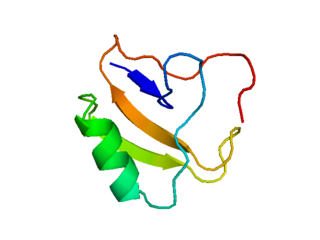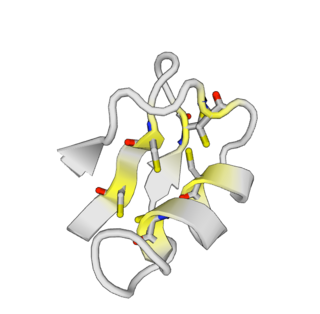Related Research Articles

Charybdotoxin (CTX) is a 37 amino acid neurotoxin from the venom of the scorpion Leiurus quinquestriatus hebraeus (deathstalker) that blocks calcium-activated potassium channels. This blockade causes hyperexcitability of the nervous system. It is a close homologue of agitoxin and both toxins come from Leiurus quinquestriatus hebraeus. It is named after Charybdis, a sea monster from Greek myth.
Iberiotoxin (IbTX) is an ion channel toxin purified from the Eastern Indian red scorpion Hottentotta tamulus. Iberiotoxin selectively inhibits the current through large-conductance calcium-activated potassium channels.
Tamapin is a toxin from the Indian Red Scorpion, which is a selective and potent blocker of SK2 channels.

Scorpion toxins are proteins found in the venom of scorpions. Their toxic effect may be mammal- or insect-specific and acts by binding with varying degrees of specificity to members of the Voltage-gated ion channel superfamily; specifically, voltage-gated sodium channels, voltage-gated potassium channels, and Transient Receptor Potential (TRP) channels. The result of this action is to activate or inhibit the action of these channels in the nervous and cardiac organ systems. For instance, α-scorpion toxins MeuNaTxα-12 and MeuNaTxα-13 from Mesobuthus eupeus are neurotoxins that target voltage-gated Na+ channels (Navs), inhibiting fast inactivation. In vivo assays of MeuNaTxα-12 and MeuNaTxα-13 effects on mammalian and insect Navs show differential potency. These recombinants exhibit their preferential affinity for mammalian and insect Na+ channels at the α-like toxins' active site, site 3, in order to inactivate the cell membrane depolarization faster[6]. The varying sensitivity of different Navs to MeuNaTxα-12 and MeuNaTxα-13 may be dependent on the substitution of a conserved Valine residue for a Phenylalanine residue at position 1630 of the LD4:S3-S4 subunit or due to various changes in residues in the LD4:S5-S6 subunit of the Navs. Ultimately, these actions can serve the purpose of warding off predators by causing pain or to subdue predators.
BmTx3 is a neurotoxin, which is a component of the venom of the scorpion Buthus Martensi Karsch. It blocks A-type potassium channels in the central nervous system and hERG-channels in the heart.

Lq2 is a component of the venom of the scorpion Leiurus quinquestriatus. It blocks various potassium channels, among others the inward-rectifier potassium ion channel ROMK1.
Birtoxin is a neurotoxin from the venom of the South African Spitting scorpion. By changing sodium channel activation, the toxin promotes spontaneous and repetitive firing much like pyrethroid insecticides do
BmKAEP is a neurotoxin from the venom of the Manchurian scorpion (Mesobuthus martensii). It is a β-toxin, which shift the activation voltage of sodium channels towards more negative potentials.
In molecular biology, the BmKK2 toxins are a family of scorpion toxins. They belong to the scorpion toxin subfamily alpha-KTx 14. They include a novel short-chain peptide from the Asian scorpion Mesobuthus martensii Karsch, a potassium channel blocker composed of 31 amino acid residues. The peptide adopts a classical alpha/beta-scaffold for alpha-KTxs. BmKK2 selectively inhibits the delayed rectifier K+ current, but does not affect the fast transient K+ current.

Mesobuthus eupeus is a polymorphic scorpion species belonging to the well-known family Buthidae. Commonly known as the lesser Asian scorpion or the mottled scorpion. It is thought to be the most widely dispersed species of the genus Mesobuthus, perhaps even of the family Buthidae.
BeKm-1 is a toxin from the Central Asian scorpion Buthus eupeus. BeKm-1 acts by selectively inhibiting the human Ether-à-go-go Related Gene (hERG) channels, which are voltage gated potassium ion channels.
Butantoxin (BuTX) is a compound of the venom of three Brazilian and an Argentinean scorpion species of the genus Tityus. Butantoxin reversibly blocks the voltage-gated K+ channels Shaker B and Kv1.2, and the Ca2+-activated K+ channelsKCa 1.1 and KCa 3.1.

Pi3 toxin is a purified peptide derivative of the Pandinus imperator scorpion venom. It is a potent blocker of voltage-gated potassium channel, Kv1.3 and is closely related to another peptide found in the venom, Pi2.
HsTx1 is a toxin from the venom of the scorpion Heterometrus spinifer. HsTx1 is a very potent inhibitor of the rat Kv1.3 voltage-gated potassium channel.
Limbatustoxin, is an ion channel toxin from the venom of the Centruroides limbatus scorpion. This toxin is a selective blocker of BK channels, calcium-activated potassium channels.

Noxiustoxin (NTX) is a toxin from the venom of the Mexican scorpion Centruroides noxius Hoffmann which block voltage-dependent potassium channels and calcium-activated potassium channels.
AaTX1 is a scorpion toxin of the α-KTx15 subfamily originally found in the venom of Androctonus australis. The toxin acts as a specific blocker on Kv4.3 voltage-gated potassium channel, thereby abolishing the A-type potassium currents.

ImKTx88 is a selective inhibitor of the Kv1 ion channel family that can be isolated from the venom of the Isometrus maculatus. This peptide belongs to the α-KTx subfamily and is classified as a pore-blocking toxin.
BmP02, also known as α-KTx 9.1 or Bmkk(6), is a toxin from the Buthus Martensi Karsch (BmK) scorpion. The toxin acts on potassium channels, blocking Kv1.3 and slowing the deactivation of Kv4.2. BmP02 is not toxic to humans or mice.
BmK NSPK is a toxin isolated from the venom of the Chinese armor-tail scorpion, which specifically targets voltage gated potassium channels (Kv), resulting in a direct inhibition of outward potassium current.
References
- 1 2 3 4 5 Strong, PN; Clark, GS; Armugam, A; De-Allie, FA; Joseph, JS; Yemul, V; Deshpande, JM; Kamat, R; Gadre, SV; Gopalakrisnakone, P; Kini, RM; Owen, DG; Jeyaseelan, K (1 January 2001). "Tamulustoxin: A Novel Potassium Channel Blocker from the Venom of the Indian Red Scorpion Mesobuthus tamulus". Archives of Biochemistry and Biophysics. 385 (1): 138–144. doi:10.1006/abbi.2000.2135. PMID 11361010.
- 1 2 3 Rodríguez de la Vega, RC; Possani, LD (15 June 2004). "Current views on scorpion toxins specific for K+-channels". Toxicon. 43 (8): 865–875. doi:10.1016/j.toxicon.2004.03.022. PMID 15208019.
- ↑ "Animal Toxin Database" . Retrieved 13 October 2014.
- ↑ Tytgat, J; Chandy, KG; Garcia, ML; Gutman, GA; Martin-Eauclaire, MF; Van der Walt, JJ; Possani, LD (1 November 1999). "A unified nomenclature for short-chain peptides isolated from scorpion venoms: α-KTx molecular subfamilies". Trends in Pharmacological Sciences. 20 (11): 444–447. doi:10.1016/S0165-6147(99)01398-X. PMID 10542442.
- ↑ Kumar, RB; Suresh, MX (10 January 2013). "Homology modeling, molecular dynamics simulation and protein-protein interaction studies on calcium activated potassium channel blocker, Tamulotoxin from Buthus tamulus". Advanced BioTech. 12 (7): 11–14. Archived from the original on 13 October 2014. Retrieved 13 October 2014.
- ↑ Singh, SK; Deshpande, SB (13 June 2008). "Injection of Mesobuthus tamulus venom in distal segment of femoral artery evokes hyperventilatory and hypertensive responses in anaesthetised rats". Neuroscience Letters. 438 (1): 64–66. doi:10.1016/j.neulet.2008.04.037. PMID 18472330. S2CID 25722401.
- ↑ Pandey, R; Deshpande, SB (August 2004). "Protective effects of aprotinin on respiratory and cardiac abnormalities induced by Mesobuthus tamulus venom in adult rats". Toxicon. 44 (2): 201–205. doi:10.1016/j.toxicon.2004.05.025. PMID 15246770.
- ↑ Bawaskar, HS; Bawaskar, PH (January 2012). "Scorpion sting: update". The Journal of Association of Physicians in India. 60: 46–55. PMID 22715546 . Retrieved 13 October 2014.
- ↑ Tiwari, AK; Deshpande, SB (December 1993). "Toxicity of scorpion (Buthus tamulus) venom in mammals is influenced by the age and species". Toxicon. 31 (12): 1619–1622. doi:10.1016/0041-0101(93)90346-K. PMID 8146875.
- ↑ Kumar, RB; Suresh, MX (April 2013). "Computational analysis of bioactive phytochemicals as potential inhibitors for calcium activated potassium channel blocker, tamulotoxin from Mesobuthus tamulus". Pharmacognosy Journal. 5 (2): 41–45. doi:10.1016/j.phcgj.2013.02.001.
- ↑ Kumar, RB; Suresh, MX (April 2013). "Pharmacophore mapping based inhibitor selection and molecular interaction studies for identification of potential drugs on calcium activated potassium channel blockers, tamulotoxin". Pharmacognosy Magazine. 9 (34): 89–95. doi:10.4103/0973-1296.111239. PMC 3680861 . PMID 23772102.